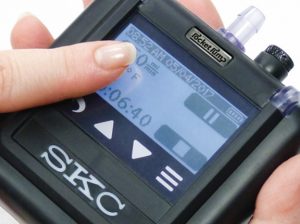Sampling Pump Innovations Make Compliance Sampling Easier
By Debbie Dietrich, Contributor
In this new decade, health and safety professionals will continue to see advances in monitoring technologies, including connected worker devices, wearables and miniature sensors. Together, these just might revolutionize chemical exposure evaluation.
Amidst these innovations lies the heart of air sampling for OSHA compliance: the personal sampling pump drawing air through sample collection media, followed by lab analysis of the samples. While long-standing OSHA and NIOSH methods using these basic sampling devices will not change quickly, advances in pump technology (from introduction to present) are rapidly making air sampling easier and more accurate.
Early Focus on Flow
When the Occupational Safety and Health (OSHA) Act was passed in 1970, air sampling pumps users identified several pain points, including limited flow range; lack of flow compensation; and inconsistent pulsating flow. Pioneers in sampling technology introduced solutions to combat these issues and eased the burden of sample collection for compliance.
-
Pulsating flow
Airflow through a sampling train must be as smooth as possible to maintain the highest sampling efficiencies, particularly when using size-selective dust samplers. Pulsation dampeners were added to pump designs that reduced pulsation in the airflow.
-
Flow compensation
A sampling pump must maintain constant flow to ensure the accuracy of chemical exposure measurements. When using early pump models, industrial hygienists had to maintain constant flow by checking the flow rate regularly and adjusting it manually with a screwdriver.
A first significant advancement in pump technology was automatic electronic flow control that compensated for restrictions in flow from filter loading, pinched tubing, etc. Flow-compensated pumps ensure constant flow within a stated range of back pressure produced by the sampling train, which makes sampling easier and more accurate.
For those new to industrial hygiene sampling, back pressure is the pressure drop produced by the sample media itself. When sampling particulates, back pressure can be exacerbated by the collected dust on the filter. Without adequate compensation capabilities, the flow of a pump will drop or completely stop with high dust loading. Today’s top-quality pumps provide flow compensation up to 40 or 60 inches of water back pressure.
Another early issue was that hygienists had to use a pump dedicated to gas and vapor (low flow < 1 L/min) sampling and one specifically for particulate (high flow >1 L/min) sampling. Advancement came with sampling pumps capable of providing both low flows and higher flows in one pump. Now, hygienists can collect either gas/vapor samples with sorbent tubes or dust samples with filters with the same pump.
Universal PCXR pumps were among the first to offer the full range of flow rates for personal air sampling with other pump models following. Today, personal sampling pumps are available with a flow range from 5ml/min to 5L/min and pulsation-free flow over the entire flow range—to ensure the accuracy that is critical to size-selective dust samplers such as cyclones.
Recent Focus on Electronics
-
Electromagnetic Susceptibility
Over time, advanced electronics and microprocessors were incorporated into all types of monitoring instruments, including air sampling pumps, to enhance capabilities. However, this advancement led to a significant pain point. Pump flow or operation could be affected by electromagnetic susceptibility (EMS), which is electromagnetic interference (EMI) and radio frequency interference (RFI) from devices such as walkie-talkies worn by workers. Similarly, EMS caused gas detectors and other instruments to go into alarm or otherwise fault. OSHA engineers addressed EMS concerns by providing guidance to instrument manufacturers on blocking and/or shielding pump electronics to meet performance specifications. Today, sampling pumps with electronics that address EMS rarely exhibit performance problems from EMI or RFI.
Over time, advances in pump design allowed for PC compatibility, making sampling pump setup and record keeping easier. Instead of manually pressing button sequences on the pump, users simply use their PC with software to set delayed start time, flow rate, and stop time. The pump is connected to PC using a cable or individual charging/communication cradles that can be chained and connected to one PC to program multiple pumps at one time.
PC software, such as DataTrac Pro, allows sampling events to be exported for inclusion in detailed records on worker and job activity, environmental conditions and sampling equipment serial numbers.
Early pump models used a built-in rotameter for rough indication of the set flow rate. Many sampling pumps today feature an LED or LCD display that indicates flow; however, flow rate must be verified and adjusted using an external certified flow calibrator before and after every sampling period.
This task has been made easier and more accurate with the development of new technology that allows pumps and flow calibrators to communicate directly and calibrate automatically. The CalChek automatic calibration feature is available for use with chek-mate certified flow calibrators and CalChek-capable air sampling pumps. The CalChek feature allows for flow calibration at a single flow rate for sampling or across a range of operational flows to reset the pump following maintenance or repair.
With the high number of monitoring instruments in a health and safety professional’s toolbox, it can be difficult for users to remember the button sequences for each. Air sampling pumps with touchscreen navigation have relieved this pain point by offering simple, intuitive operation and often eliminate the need for an instruction manual.
-
Remote Operation Using Bluetooth
This latest development allows pump operation via a pump-specific app on a mobile device. An example is the Smart Wave App, which allows users to start/stop the low flow Pocket Pump TOUCH and adjust flow using IOS® or Android tablets and phones.
Given the number and complexity of chemicals found in the workplace, air sampling pumps and collection media will remain an essential tool in the air monitoring toolbox. While air sampling pumps were an early solution, they remain the heart of air sampling for OSHA compliance and continue to evolve with new features that make compliance sampling easier. IHW
Debbie Dietrich, CIH, is a Corporate Industrial Hygienist for SKC. (skcinc.com)







